|
|
 |
Sagalassos
high up in the Toros mountains |
 |
|
| |
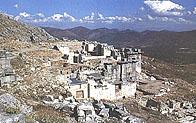 |
 |
the ancient town of
Sagalassos
|
The ancient ruins of Sagalassos
are situated 7 km from the town of Aglasun in the province of Burdur. The city lies on Mount Akdag, a spur of the
Western Toros range, at an altitude of between 1450 and 1700 metres.
Human settlement in the area goes back to 12.000 BC, and Sagalassos itself reveal traces of settlement going back
to 3000 BC. Around 1600 it became part of Pisidia, but otherwise its history remains wreathed in mist until the
arrival of Alexander the Great in 334 BC. Sagalassos was renowned for its courageous and warlike inhabitants, who
put up a vigorous defense against Alexander's army. The city was finally 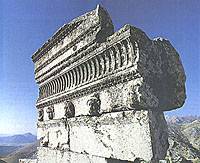 conquered after the loss of five hundred lives in a battle which took place
on a hilltop facing the city. conquered after the loss of five hundred lives in a battle which took place
on a hilltop facing the city.
Sagalassos enjoyed a period of prosperity after Alexander, and throughout the Hellenistic period (333-25 BC) was
the second most important city of Pisidia. In 25 BC Sagalassos became part of the Roman Empire and in the 1st century
AD became the foremost city of the region. From then until the early 3rd century the city enjoyed a golden age
and many magnificent buildings were constructed here.
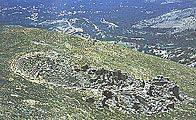 |
 |
Sagalassos had the highest
amphi theatre in the world |
In 518 AD a violent earthquake struck. Although the city was subsequently rebuilt, another earthquake in the 7th
century destroyed not only the city but its water sources. Lack of water and disease were compounded by the Arab
incursions, and finally the city was abandoned altogether. Landslides from Mount Akdag gradually buried much of
the city and, thus protected, Sagalassos lay concealed in hibernation for long centuries.
In 1706 the French traveler Paul Lucas arrived in Sagalassos, which he describes as a city of enchantment. Not
until 1824 did the British cleric Francis Arundell discover the city's true identity. In 1985 a team of British
researchers led by Stephen Mitchell visited the site, and the following year they were joined by Belgian archaeologist
Prof Dr. Marc Waelkens, the man who was to awaken Sagalassos from its centuries of oblivion. When Waelkens and
Mitchell carried out surface exploration at this remote site like an eagles eerie high in the mountains, they were
astounded not only by the ruins but by the spectacular view over the green plain.
Thanks to the city's inaccessibility the ruins had not been plundered for building material or by antiquity hunters,
and remained so remarkably intact that Marc Waelkens was overcome by excitement. This was the site of his dreams,
and immediately he obtained the necessary permits to carry out excavations. With the
financial and technical support of Leuven Catholic University in Belgium where he taught, excavations went ahead
in 1990.
Waelkens invited experts in a range of fields from various countries to loin the large team, and within ten years
- a brief period in archaeological research terms - most of Sagalassos was revealed and reconstruction of some
buildings had commenced. The principle structures uncovered by the excavations are a Doric temple (1st century
BC), 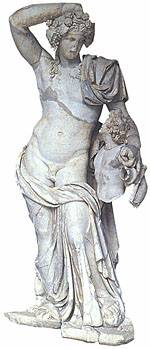 a late Hellenistic
fountain (1st century BC), the Neon Library (second century AD, a bouleuterion or assembly building seat-ing two
hundred people (125-100 BC), the upper and lower agoras (2nd century BC), a heroon (hero's memoriaL) thought to
commemorate Alexander the Great dating from the reign of Augustus (14 AD), Temple of Apollo Clarios (0-20 AD),
Temple of Antinius Pius (120-140 AD), Antonines Fountain (161-180 AD), a theatre seating nine thousand people which
is the highest in the world (2nd century AD), Roman bath (2nd century AD), and a public lavatory accommodating
forty people. a late Hellenistic
fountain (1st century BC), the Neon Library (second century AD, a bouleuterion or assembly building seat-ing two
hundred people (125-100 BC), the upper and lower agoras (2nd century BC), a heroon (hero's memoriaL) thought to
commemorate Alexander the Great dating from the reign of Augustus (14 AD), Temple of Apollo Clarios (0-20 AD),
Temple of Antinius Pius (120-140 AD), Antonines Fountain (161-180 AD), a theatre seating nine thousand people which
is the highest in the world (2nd century AD), Roman bath (2nd century AD), and a public lavatory accommodating
forty people.
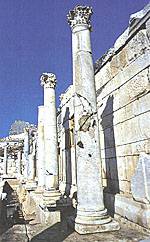 The
first two years of work were devoted mainly to the Neon Library and the mosaic pavement in front of this building,
and to the late Hellenistic fountain. Almost all the architectural elements of both library and fountain were in
situ, and between 1992 and 1997 architectural restorers Semih Ercan and Teresa Patricio reconstructed both buildings.
At the same time, the water source which had fed the fountain was unblocked, so that it began to flow again. This
is the first time in Turkey that the original function has been restored to an antique structure. The
first two years of work were devoted mainly to the Neon Library and the mosaic pavement in front of this building,
and to the late Hellenistic fountain. Almost all the architectural elements of both library and fountain were in
situ, and between 1992 and 1997 architectural restorers Semih Ercan and Teresa Patricio reconstructed both buildings.
At the same time, the water source which had fed the fountain was unblocked, so that it began to flow again. This
is the first time in Turkey that the original function has been restored to an antique structure.
Since 1997 work has focused on the area around the upper agora, which formed the central hub of Sagalassos, and
the Antonines Fountain on the north side of the agora. The facade of this imposing fountain is like a theatre proscenium,
with niches containing statues made in Aphrodisias and Afyon Incehisar. It is estimated that work on the fountain
will be completed in five or six years time, restoring it to its original glory.
Two splendid statues of the god Dionysus, 2.65 and 2.45 metres high respectively, and statues of various sizes
representing august citizens of Sagalassos discovered during excavation of the fountain are today exhibited in
Burdur Museum. When the restoration work being carried out by Semih Ercan is complete, replicas of these statues
will be placed on the fountain, and the water main linking it to the Hellenisticfountain restored so that the water
will flow here again. The 14 metres high heroon in the upper agora is another important structure which will be
rebuilt, and restoration is underway by a team led by Ebru Torun Popleme. The most striking feature of the heroon
is a frieze depicting women dancing in a trance, with disdraped cloths and musical instruments in their hands.
Conservation work is still continuing on this frieze, whose Hellenistic folds are superbly sculpted.
When the area around the upper agora is completed, visitors will be able to gain a fuller perception of Sagalassos.
Once again the city will gleam like a pearl set in the rocky heights of the Toros.
Sagalassos is 110 kilometres from Antalya Airport, and is also within easy reach for those traveling between Antalya
and Pamukkale or Antalya and Cappadocia. It is just 30 kilometres from the cities of Burdur and Isparta. If you
visit Sagalassos between 1 June and 1 September, you will be able to watch the archaeologists at work and enjoy
a free guided tour by volunteers in English, French, German and even Flemish
|
|
|
© copyright
2000 ~ all rights reserved pixelwork-webdesign Bodrum & Istanbul       
|
|
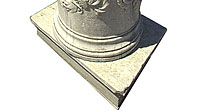
| |
| these pages are best viewed with the
MS Trebuchet font, you may download it here |
 |
 click on pictures to
enlarge click on pictures to
enlarge |
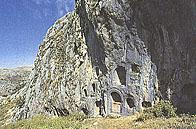 |
| The rock tombs here are unique |
 |
 |
 |
 click on pictures to
enlarge click on pictures to
enlarge |
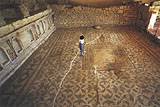 |
| The fountain inside |
 |
 click on pictures to
enlarge click on pictures to
enlarge |
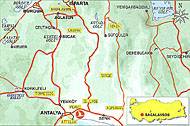 |
|
|